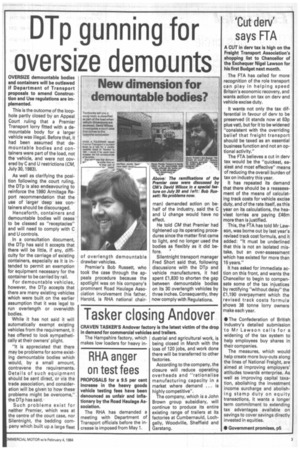DTp gunning for
Page 5

If you've noticed an error in this article please click here to report it so we can fix it.
oversize demounts
OVERSIZE demountable bodies and containers will be outlawed if Department of Transport proposals to amend Construction and Use regulations are implemented.
This is the outcome of the loophole partly closed by an Appeal Court ruling that a Premier Transport lorry fitted with a demountable body for a larger vehicle was illegal. Before that, it had been assumed that demountable bodies and containers were part of the load, not the vehicle, and were not covered by C and U restrictions (CM, July 30, 1983).
As well as clarifying the position following the court ruling, the DTp is also endeavouring to reinforce the 1980 Armitage Report recommendation that the use of larger deep sea containers should be discouraged.
Henceforth, containers and demountable bodies will cease to be classed as "receptacles" and will need to comply with C and U controls.
In a consultation document, the DTp has said it accepts that there will be little, if any, difficulty for the carriage of existing containers, especially as it is intended to permit an exemption for equipment necessary for the container to be carried by rail.
For demountable vehicles, however, the DTp accepts that there are many existing vehicles which were built on the earlier assumption that it was legal to run overlength or overwidth bodies.
While it has not said it will automatically exempt existing vehicles from the requirement, it has offered to look sympathetically at their owners' plight "It is appreciated that there may be problems for some existing demountable bodies which would, by a small amount, contravene the requirements. Details of such equipment should be sent direct, or via the trade association, and consideration will be given to how these problems might be overcome," the DTp has said.
Such problems exist for neither Premier, which was at the centre of the court case, nor Silentnight, the bedding company which built up a large fleet of overlength demountable drawbar vehicles.
Premier's Bob Russett, who took the case through the appeals procedure because the spotlight was on his company's prominent Road Haulage Association involvement (his father, Harold, is RHA national chair man) demanded action on behalf of the industry, said the C and U change would have no effect.
He told CM that Premier had tightened up its operating procedures since the matter first came to light, and no longer used the bodies as flexibly as it did before.
Silentnight transport manager Fred Short said that, following discussions with the DTp and vehicle manufacturers, it had spent £1,830 to shorten the gap between demountable bodies on its 30 overlength vehicles by three inches. Consequently, they now comply with Regulations.
































































































